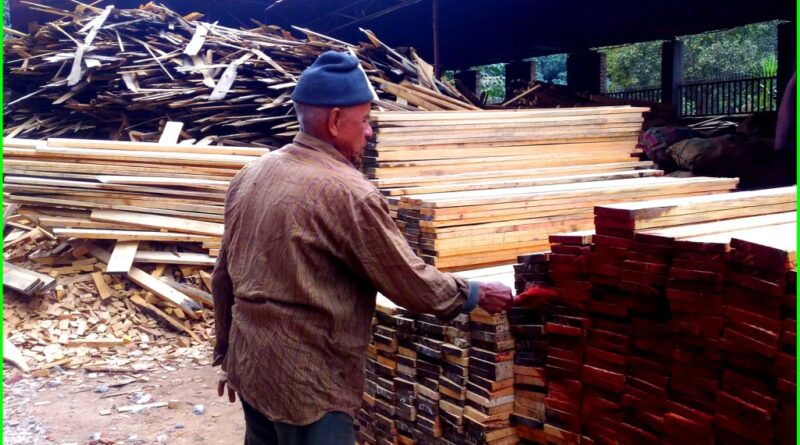Accuracy in forest mensurations
Even though mensuration is a branch of mathematics, forest mensuration does not attempt to secure absolute mathematical accuracy. For the purpose of sale, a very high degree of accuracy in estimation of volume of timber in a lot, is neither necessary nor desirable. Though insistence of high degree of accuracy in forest mensuration results in reduction of waste and exercises a control on the methods of working of forests, there is a limit beyond which economic gains, which may accrue from the adoption of elaborate methods, are incommensurate with the time and money spent on them. Thus, forest mensuration aims at reasonable or relative accuracy, i.e., maximum accuracy which is profitable and possible to obtain in practice. The following are some of the reasons which compel foresters to be content with relative accuracy.
(a) Characteristics of trees
The shapes of trees differ very greatly from one another. Some trees have short stems and big crowns while others
have long stems and small crowns. They also differ .widely in lengths and sizes of stems and their forms. The cross-sections of stems of trees do not correspond strictly to any geometrical form. The characteristic of having cross-sections of stems deviating from circular shape without conforming to any geometrical form introduces error in calculation of cross-sectional areas as they are assumed to be of some definite geometric shape-. The variation in the degrees of eccentricity from tree to tree further complicates the problem.
The swelling near the base of the trees, fluting, buttresses and thickness of bark introduce so many variables that no single formula can correctly estimate the quantity of timber available from a standing tree.
(b) Varying methods and conditions of felling and conversion —
A standing tree has to be felled and converted to obtain the timber it contains. The relation which the volume of timber in a standing tree bears to the converted material depends not only on the skill and care with which felling and conversion are done but also on local conditions. When felling and conversion are done unskillfully involving a lot of waste as happens in the rough squaring of timber in the hills and when local conditions are such that conversion and export of all material are not economic, it is no use aiming at a high degree of accuracy in measurements. As Chaturvedi (26) said, 'The life-long devotion of Simony and Schiffel to the mathematics of stem as a solid of revolution would seem so much labour lost in the face of the American practice of felling trees 10-15 feet above ground level, a procedure which is based not on mathematical but on economic grounds'.
(c) Instruments and conditions in which they are used —
The instruments used for making measurement of trees and the conditions in which they are used impose a physical limit to the degree of accuracy that can he attained. For instance, Abney's level with its vernier gives only approximate angles of elevation and depression not only because of the natural Obstructions in sighting the top and base of the tree respectively but also because the instrument is likely to shake while being used without a stand. Measurement of distance from the observer to the tree further contributes to the inaccuracy and thus the measurement of height of a tree is, at best, an approximation which is subject to errors.
(d) Personal bias of the estimator —
Predictions of volume of trees and crops in future have to be based on the growth of trees and crops supposed to he growing in similar conditions or have to be projected for future, assumin2, that the conditions of growth in the immediate past will continue to remain the same in the near future as well. In both these cases, personal bias of the estimator and nature of tree growth influences the judgement considerably and consequently the estimate.
(e) Biological character of the forest —
The forest is a living entity and its growth is a function of several factors acting simultaneously. The results of these complex factors cannot be predicted with mathematical accuracy. Trees growing in a crop are affected not only by climate, edaphic and topographic conditions but also by degree of congestion and biotic factors and therefore growth functions of trees can, at best, be rough estimates.
(f) The use to which the measurements are to be put —
The accuracy to be aimed at, also depends upon the use to which the data are to be put. When the value of the produce is low, as in the case of fuel or miscellaneous forests. it would be a sheer waste of time and money to measure the dimensions with the same meticulous care and accuracy as in the case of valuable timber forests. t Even in the valuable species, the same degree of accuracy is not necessary in case of immature forests as in the case of areas with mature crops nearing harvest time. Similarly, the routine forest measurements do not deserve the same degree of accuracy with which measurements in a sample plot are carried out for statistical or research work.
(g) Cost
Cost is another important factor that governs the accuracy to be aimed at. In estimating volume of a stand, detailed measurements of each tree would make the cost prohibitive and as standing timber is not the finished product, its volume and value are affected by the skill and care of the crew employed in felling and conversion. It is, therefore, not desirable to spend too much money and time on accurate measurement of volume of standing trees. The degree of accuracy will depend on the objectives of the estimate.


